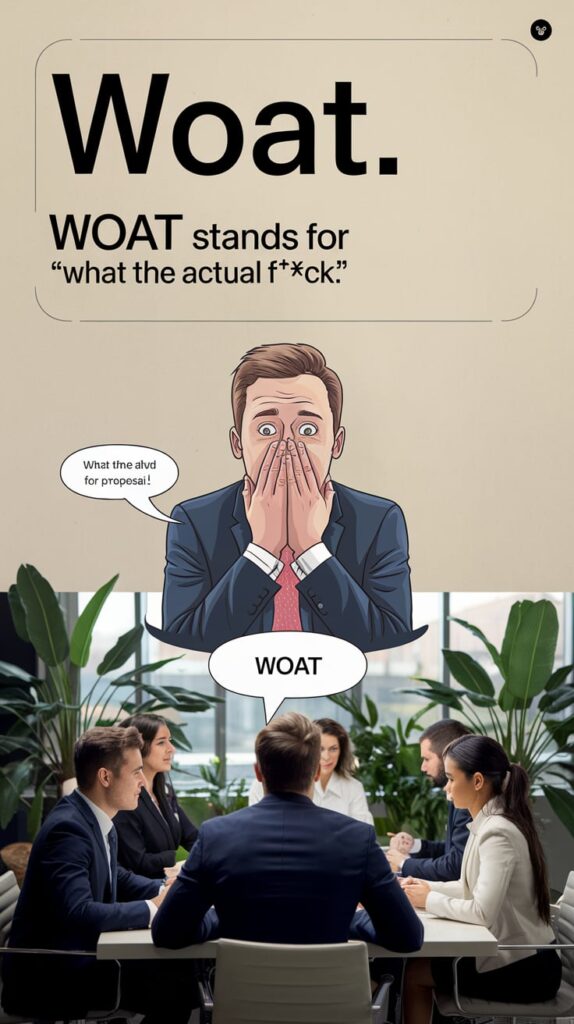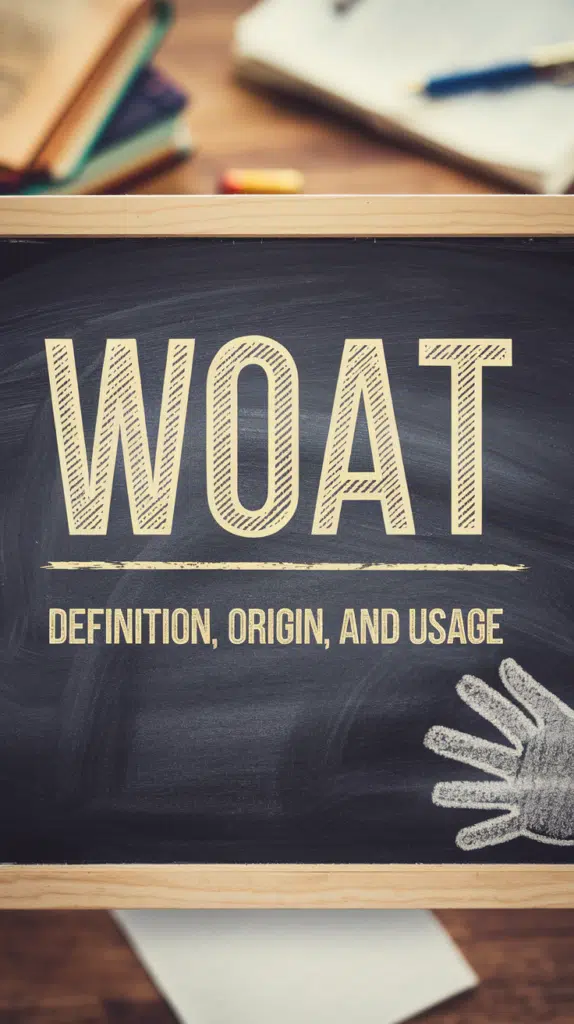What Does “WOAT” Mean?
In the dynamic realm of internet slang, acronyms have revolutionized communication, allowing us to express complex ideas succinctly. One such term that has gained significant traction is what does “WOAT definition,
an acronym standing for “Worst of All Time.” This article will provide an in-depth exploration of what does”WOAT” mean, its origins, common usage, and how it contrasts with similar acronyms
. With the rise of social media platforms like TikTok, Instagram, and Snapchat, understanding “WOAT” can enhance your engagement in modern conversations.

read more : Understanding WYF Meaning in Text – Grammar Beacon
Understanding “WOAT”
“WOAT” Definition
At its core, “WOAT” signifies something or someone deemed the absolute worst in a particular category. It’s a bold statement often used to criticize performances, products, or decisions.
For instance, labeling a movie as the “WOAT” implies that it not only failed to meet expectations but also stands out negatively compared to its peers.
Key Characteristics of “WOAT”:
- Absolute Judgment: “WOAT” is definitive, indicating no room for debate.
- Context-Specific: It applies to various contexts, from sports to pop culture.
- Cultural Relevance: Its usage often reflects current trends and sentiments.
Common Contexts for Use
“WOAT” appears across numerous contexts, primarily in discussions about:
- Sports: Fans frequently label poor performances or teams as the “WOAT.”
- Entertainment: Movies, music, and television shows receive scrutiny under this label.
- Everyday Life: People humorously use “WOAT” to describe mundane experiences.
Examples of “WOAT” in Sentences
Casual Conversations
In everyday dialogues, “WOAT” often arises in playful contexts. Friends might joke about a shared bad experience:
- Example: “That pizza we ordered was the WOAT; I can’t believe we thought it would be good!”
- Example: “His last album was the WOAT of the year—no comparison!”
Social Media Usage
On platforms like TikTok and Instagram, “WOAT” finds its way into memes and comments, amplifying its reach. Users often pair it with visuals to emphasize their critique:
- Example: A TikTok featuring a sports blunder might be captioned, “This play is the WOAT of the season!”
- Example: An Instagram post about a poorly reviewed film might read, “This movie is the WOAT. Save your money!”
The Origin and defination of “WOAT”
How the Term Came About
The term “WOAT” emerged as a direct counterpoint to “G.O.A.T,” which stands for “Greatest of All Time.” As “G.O.A.T” gained immense popularity, particularly in sports and music discussions,
the need for a contrasting term became apparent. “WOAT” allowed fans and critics alike to express disappointment and frustration.

Evolution Over Time
Since its inception, “WOAT” has evolved. Initially used by niche groups, it now enjoys widespread recognition across various demographics and platforms.
The advent of social media has been pivotal in this transformation, facilitating rapid dissemination and understanding of the term.
Similar Acronyms: What Does “FASOTP” Mean?
Definition and Context of FASOTP
Another acronym gaining attention is “FASOTP,” which stands for “Fastest of All Time.” It serves as a positive classification, highlighting exceptional performance.
Comparison with “WOAT”
While “WOAT” serves a critical purpose, “FASOTP” emphasizes excellence. For instance:
- WOAT Usage: “That was the WOAT decision in the playoffs; they should have never gone for it on fourth down.”
- FASOTP Usage: “His sprint during the finals was the FASOTP; nobody has ever run that fast!”
How to Use “WOAT” Effectively
Tips for Contextual Usage
To harness the term “WOAT” effectively, consider these strategies:
- Know Your Audience: Ensure that your audience understands the slang, especially in formal settings.
- Be Mindful of Context: Use “WOAT” where it’s warranted; avoid overuse to maintain its impact.
- Stay Humorous: Employ humor when using “WOAT” to lighten the conversation.
Avoiding Common Mistakes
A frequent mistake is applying “WOAT” too liberally. Not every negative experience deserves this strong label. Reserve “WOAT” for instances that genuinely call for it, ensuring your critiques remain valid.
read more : 15 Creative Alternatives to Stay Tuned Synonyms – Grammar Beacon
The Impact of “WOAT” in Modern Communication
Cultural Significance of “WOAT”
“WOAT” reflects our changing communication landscape, where brevity and punchiness reign supreme. Its impact is especially evident in how we engage on social media.
With the rapid exchange of opinions, “WOAT” serves as a shorthand for expressing dissatisfaction quickly and effectively.
Psychological Aspects of Using “WOAT”
Using “WOAT” taps into our shared cultural understanding of what constitutes failure. It provides a way to bond over shared experiences, making it a valuable tool for social interaction. Here’s how it functions psychologically:
- Validation: When someone uses “WOAT,” it validates the feelings of others who share that opinion.
- Humor: The term often carries a humorous connotation, allowing users to lighten up discussions about failures.
Analyzing “WOAT” in Social Media Trends
Search Trends and Popularity
Analyzing Google Trends reveals spikes in searches for “WOAT,” particularly during specific events like sports seasons or movie releases. The term gains traction when public sentiment aligns with disappointment in a widely discussed topic.
| Event | Search Volume for “WOAT” |
| Sports Finals | High |
| Major Movie Releases | High |
| Award Shows | Moderate |
Trend Data Visualization
Visual representations of search trends show how “WOAT” correlates with public sentiment. For example, during the NFL playoffs, the term often trends as fans react to poor performances.

read more : 20 Beautiful Ways to Say Rest in Peace – Grammar Beacon
Real-World Applications of “WOAT”
Case Studies in Sports Criticism
In the world of sports, “WOAT” serves as a powerful tool for fan expression. For instance, when a highly favored team loses spectacularly, fans quickly take to social media to label the performance as the “WOAT.”
This phenomenon isn’t limited to just one sport; it spans across basketball, football, and baseball, showcasing the term’s versatility.
- Example: After a championship game, a fan might tweet, “That last play was the WOAT decision ever made in sports history!”
Cultural Commentary
“WOAT” also finds a place in cultural commentary. Critics of films, music, and television use it to express disdain for particular works. This usage becomes especially prominent during award seasons,
where nominees are scrutinized, and discussions about what deserves recognition intensify.
- Example: During the Oscars, critics might remark, “That nominee was the WOAT; how did it even get nominated?”
How to Navigate the “WOAT” Landscape
Engaging with “WOAT” in Discussions
When entering discussions that involve “WOAT,” consider the following:
- Stay Informed: Familiarize yourself with the context in which “WOAT” is used to avoid misinterpretation.
- Be Respectful: While critiquing is essential, ensure that your comments remain constructive and not overly harsh.
Potential Misinterpretations
One of the risks of using “WOAT” is potential misinterpretation. Some may perceive it as overly harsh or negative. To mitigate this:
- Clarify Intent: If using “WOAT” in a discussion, clarify your intent to prevent misunderstanding.
- Use Humor Wisely: Employ humor to soften the blow, making your critique more palatable.
Future of Terms Like “WOAT”
The Evolution of Slang
As language evolves, so too do terms like “WOAT.” The emergence of new platforms and communication styles will likely shape how “WOAT” is perceived and utilized. It’s essential to stay attuned to these changes to engage effectively.
Predictions for “WOAT”
Looking ahead, it’s likely that “WOAT” will continue to thrive as internet culture evolves. The need for concise expressions of opinion will remain relevant, ensuring that terms like “WOAT” hold their place in the lexicon of modern slang.
The Role of Acronyms in Communication
In summary, “WOAT” definition serves as a vital part of contemporary slang, encapsulating dissatisfaction succinctly. Its presence in casual conversations, social media, and cultural critiques highlights its versatility and importance.
Final Thoughts on “WOAT” definition
Understanding “WOAT” definition not only enriches your vocabulary but also enhances your engagement in conversations, particularly on social media. As language continues to evolve, embracing terms like “WOAT” keeps your communication relevant and engaging.
Whether you’re critiquing a performance, discussing a film, or simply bantering with friends, “WOAT” adds a layer of depth to your interactions.

Steve Rogars is an experienced blogger and language enthusiast at Grammar Beacon. With a passion for clear communication and a keen eye for detail, he shares insights on grammar, writing tips, and language trends. Steve’s engaging style makes learning enjoyable, helping readers enhance their writing skills. When he’s not crafting posts, he enjoys reading, exploring new cultures, and inspiring others to appreciate the beauty of language.







